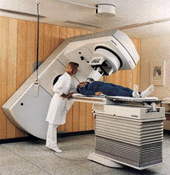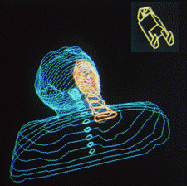
The technologist prepares a patient for radiotherapy of the neck
Many radiation therapy planning and treatment sessions are similar and follow this general procedure:
- Patients prepare by removing any articles of clothing or jewelry that may interfere with the therapy session. In some cases, the patient may be asked to wear a patient gown.
- In order to maximize reproducibility and accuracy of the treatment, the patient will lie on the simulator or treatment table for the all the planning and treatment phases. Patients must do their best to lie still and not move. Patients should not be afraid to ask questions during planning and treatment.
- Radiation therapy is preceded by a treatment simulation where the tumor is imaged using a device that simulates the path of the radiation beam.
- Radiation treatments are divided over many sessions encompassing several weeks. Because of this, very tiny marks, or tattoos, are made on the patient's skin to ensure the accuracy of treatment.
- For daily treatments, the patient is positioned by the therapist on the treatment table. Patient positioning is very important for treatment delivery accuracy. The patient is asked to relax and breathe normally during the treatment. The patient may communicate at any time with the therapist during the radiation therapy session.
- The actual treatment delivery session can last anywhere from 5 to 15 minutes. The radiation is invisible and creates no sensation when it passes through the patient's body.
- At the conclusion of treatment, the patient is helped off the table by the therapist. The patient can resume his normal daily activities. Many patients continue to work during radiation treatments.

Computer simulation of radiotherapy treatment of the throat and esophagus
External radiation therapy is usually given on an outpatient basis in a hospital or outpatient center. The treatments can be given up to five days per week for several weeks. Patients are not radioactive during or after the treatment.
For internal radiation therapy, the patient usually stays in the hospital for a few days. The implant may be temporary or permanent. Because the level of radiation is highest during the hospital stay, patients may not be able to have visitors or may have visitors only for a short time. Once the implant is removed, there is no radioactivity in the body. The amount of radiation in a permanent implant will have decreased to a safe level before the patient is allowed to leave the hospital.



